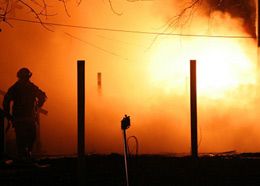By FireRescue1 staff
 Photo Tod Parker/Phototac.com Structure fires are by far the most dangerous for firefighters, according to the report. |
WASHINGTON — Twice as many firefighters are injured each year performing fireground duties as there are fire injuries to the civilian population, according to a new report.
Career firefighters aged between 35-39 who are working to extinguish residential structure fires are most likely to suffer fire-related injuries, the report said.
The comprehensive statistical breakdown of non-fatal firefighter injuries reported in 2004 was released Friday by the USFA, using the National Fire Incident Reporting System.
While the report excludes many groups, for example departments whose records were incomplete, it provides a good basis for understanding the frequency of fire-related injuries.
“Every day, firefighters face great risks of bodily injury and possibly even death,” said National Fire Data Center Director Alex Furr. “Firefighting, by its very nature, is an extremely dangerous job, and therefore it is important that we take steps to educate the fire service on improving firefighter health and safety and focus on injury prevention.”
The report breaks down injuries by the age, gender and career/volunteer status of the firefighter who was hurt.
Younger volunteers are more likely to be injured than their career-firefighter counterparts. More than a quarter of volunteers injured were under 25.
The study also examined conditions on the fireground at the time of injury-causing incidents.
Fires that were confined to the building of origin are the primary source of both single- and multiple-injury incidents, compared with fires confined to the room or floor of origin, and larger fires that spread beyond their building of origin.
Vacant or under-construction properties were given special consideration by the USFA. The report listed several reasons why they make particularly risky firegrounds. “In general, these fires are frequently arson-related with multiple ignition points. The layout is often unfamiliar and … continually changing. In addition, construction equipment, materials, and debris scattered about the site increase the risk of serious injuries,” it said. “Many of these fires are started when no one is around and the fire spreads rapidly before the fire department is called.”
Other environmental factors may increase the likelihood of injury:
Full report: Fire-Related Firefighter Injuries in 2004

